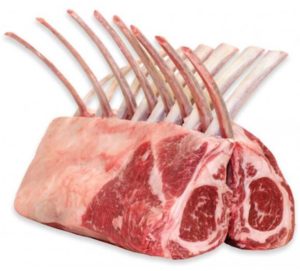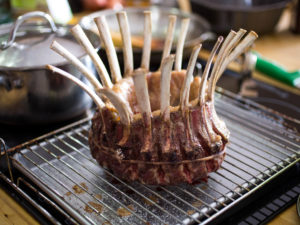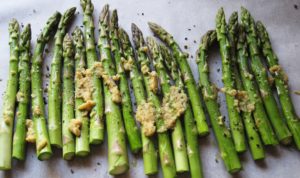SPRING LAMB FOR EASTER
TODAY’S LESSON: Young Lamb is the perfect feast for Easter. The rack of lamb is not only the most tender but is the mildest in rich flavor as well. Today we will explore the rib rack in all its glorious splendor.
WHAT EXACTLY IS A CROWN ROAST OF LAMB? The crown roast is actually two racks of lamb curved to form a circle with the bones rising upwards, looking almost like a crown when completed and, hence, its title.
WHY LAMB FOR THE HOLIDAYS? The typical ham that has been done on Easter or the standard roast ribs of beef are delicious but a little basic, while lamb is just extra special.
LAMB IN HISTORY: No meat animal has had as long and profound an associations with civilized people as sheep and their offsprings. Curly-horned wild sheep called mouflons, whose descendants still exist on Sardinia and Corsica, were domesticated tens of thousands of years ago in what is now Kurdistan. This long association has nourished civilizations for all of our history and is a perfect match for this special time of year.
ISN’T LAMB STRONGER IN FLAVOR THAN OTHER MEATS? Lamb is technically under 12 months of age often harvested AT 6 TO 9 months of age when it is even milder and more tender. Lamb older than a year is called mutton and is much more pronounced in flavor, primarily from the mature fat content. Throughout its growth, lamb produces none of the fat marbling that is common in prime beef. The fat occurs in lamb around the meaty muscles and in mature animals between the muscles. The fat may be easily trimmed away before cooking.
 HOW TO SELECT YOUR LAMB: The best grades of lamb are prime and choice. Prime has the higher fat content, most of which will be trimmed away. Choose prime, if cost is no object, or choice, if you prefer to spend that extra money on your holiday bottle of vino. Select light red meat from more flexible pink bones which depicts a younger animal. Avoid mature lamb with dark red meat and yellowish fat from whitish bones. The diameter of the “eye” of the meat on the rack should be about 1-1/2 inches to 2 inches across. The lamb should be moist but never slimy. Select two racks of lamb, 8 to 9 bones each, of equal size and weight for even cooking.
HOW TO SELECT YOUR LAMB: The best grades of lamb are prime and choice. Prime has the higher fat content, most of which will be trimmed away. Choose prime, if cost is no object, or choice, if you prefer to spend that extra money on your holiday bottle of vino. Select light red meat from more flexible pink bones which depicts a younger animal. Avoid mature lamb with dark red meat and yellowish fat from whitish bones. The diameter of the “eye” of the meat on the rack should be about 1-1/2 inches to 2 inches across. The lamb should be moist but never slimy. Select two racks of lamb, 8 to 9 bones each, of equal size and weight for even cooking.
TRIM YOUR LAMB, OR HAVE YOUR BUTCHER DO IT: Trim the fat and connective tissue covering the meaty loin. “French” the bones which is trimming the meat from between the rib bones down to where the loin attaches onto the bones, scraping the bones clean with the blade of the knife. Repeat with the second rack. Take the trimming and remove the meaty sections for stock and sauces. Discard the fat.
FORM THE CROWN: Take a large can about 5 to 6 inches in diameter, placing it in the center of your roasting pan rack. Arch the two racks of lamb, meat side out, around the can until the ends of the two racks touch each other. Wrap butchers twine around the racks just above the meat line to secure the meat in the “crown” circular shape. Remove the can carefully so that the lamb stays securely in place. Season the lamb well.
 THE COOKING BEGINS: Start roasting in a preheated oven at 400 degrees F. to develop the rich, robust meat flavor. Continue at this temperature for rare and medium rare meat. Turn down the temperature to 350 degrees F if you prefer your meats medium or more done. Test the roast with a small instant- style meat thermometer to detect your preferred degree of doneness.
THE COOKING BEGINS: Start roasting in a preheated oven at 400 degrees F. to develop the rich, robust meat flavor. Continue at this temperature for rare and medium rare meat. Turn down the temperature to 350 degrees F if you prefer your meats medium or more done. Test the roast with a small instant- style meat thermometer to detect your preferred degree of doneness.
GIVE THE LAMB A REST: Allow the roast to rest about 5 minutes before serving. This lets the juices settle down before carving. Cutting the lamb without resting allows the juices which have been trapping in the lamb during the cooking to quickly escape.
SERVING SUGGESTIONS: As long as the oven is on, roast some seasonal vegetables such as fennel bulb, artichokes and your other spring favorites. Choose colorful vegetables and shapes that when done may be presented in the center of your “crown” of lamb. Roasting is simple by splashing with a little olive oil and seasonings, letting the hot even do the rest until they are tender. Cover with foil if they begin to brown too much.
HERBS THE WORD: Don’t forget a little fresh rosemary or thyme which is the perfect flavor match. Select two racks of lamb, 8 to 9 bones each, of equal size and weight for even cooking. Garlic is the natural flavor for lamb so be generous. I can just smell all the wonderful holiday aromas coming from your kitchen.
TRY YOUR TECHNIQUE: Try this little basic twist on a Crown Roast of Lamb and you will start a new Easter tradition.
EASTER CROWN ROAST RACK OF LAMB WITH ASPARAGUS
Makes 4 generous servings
2 racks of lamb, about 8 to 9 bones each, trimmed of the fat covering and the bones
“Frenched” or trimmed to the meat loin
1 tablespoon minced garlic
sea salt
freshly ground black pepper
extra virgin olive oil
1 tablespoon chopped fresh rosemary
12 large garlic cloves
20 jumbo asparagus spears, coarse lower third trimmed
1 cups light vegetable or poultry stock
2 cups dry red wine
1/4 cup chopped mint
1/4 cup snipped fresh chives
1 bunch of mint for garnish
Preheat your oven to 400 degrees F.
Take a large can about 5 to 6 inches in diameter, placing it in the center of your roasting pan rack. Arch the two trimmed racks of lamb, meat side out, around the can until the ends of the two racks touch each other. Wrap butchers twine neatly around the racks just about the meat line to secure the meat in the “crown” circular shape. Remove the can carefully so that the lamb stays securely in place. Rub the meat of the lamb with the minced garlic. Season with salt and pepper. Drizzle a couple of drops of olive oil on the lamb meat and rub evenly across the surface to adhere the garlic and spices. Sprinkle the chopped rosemary over the lamb.
Place the roasting pan on a rack on the middle of the oven. Cook at 400 degrees for about 10 minutes to sear. Continue cooking at this temperature for rare and medium rare meat or turn down the temperature to 350 degrees F if you prefer your meats medium or more done. Test the roast with a small instant style meat thermometer to detect your preferred degree of doneness after about 25 to 35 minutes depending on the size of your lamb. Remove and allow to rest in a warm spot.
 Meanwhile, in a large bowl combine the garlic cloves with a splash of olive oil just to coat. Season with salt and pepper. Combine with the asparagus to coat. Transfer to a baking dish, placing the baking dish in preheated oven at 400 degrees F. on a lower rack under the lamb. Cook until tender and slightly browned and tender, about 20 minutes, reserving in a warm place.
Meanwhile, in a large bowl combine the garlic cloves with a splash of olive oil just to coat. Season with salt and pepper. Combine with the asparagus to coat. Transfer to a baking dish, placing the baking dish in preheated oven at 400 degrees F. on a lower rack under the lamb. Cook until tender and slightly browned and tender, about 20 minutes, reserving in a warm place.
While all this roasting is going on, in a medium saucepan combine the stock and the wine. Bring to a boil over high heat and cook until reduced to coat the back of a spoon, about 15 minutes. Remove from the heat.
To serve: Return the sauce to the heat and bring to a simmer over medium high heat. Season with salt and pepper to your taste. Remove from the heat, stir in the mint and chives and transfer to a serving boat keeping warm.
Meanwhile, return the lamb and asparagus to the oven until hot, probably about 5 minutes. Remove from the oven. With a couple of metal spatulas, carefully transfer the crown roast to the center of your serving platter. Arrange the roasted asparagus into the center of the crown sticking upwards in celebration. Stick the sprigs of mint in the center of the crown for garnish. Serve with the sauce drizzled over or on the side.
Jimmy Schmidt